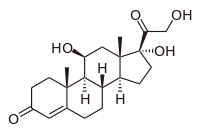
Photo from wikipedia
Abstract Although nonsteroidal anti-inflammatory drugs are the first line of therapeutics for the treatment of mild to moderate somatic pain, they are not generally considered to be effective for neuropathic… Click to show full abstract
Abstract Although nonsteroidal anti-inflammatory drugs are the first line of therapeutics for the treatment of mild to moderate somatic pain, they are not generally considered to be effective for neuropathic pain. In the current study, direct activation of spinal Toll-like 4 receptors (TLR4) by the intrathecal (IT) administration of KDO2 lipid A (KLA), the active component of lipopolysaccharide, elicits a robust tactile allodynia that is unresponsive to cyclooxygenase inhibition, despite elevated expression of cyclooxygenase metabolites in the spinal cord. Intrathecal KLA increases 12-lipoxygenase-mediated hepoxilin production in the lumbar spinal cord, concurrent with expression of the tactile allodynia. The TLR4-induced hepoxilin production was also observed in primary spinal microglia, but not in astrocytes, and was accompanied by increased microglial expression of the 12/15-lipoxygenase enzyme 15-LOX-1. Intrathecal KLA-induced tactile allodynia was completely prevented by spinal pretreatment with the 12/15-lipoxygenase inhibitor CDC or a selective antibody targeting rat 15-LOX-1. Similarly, pretreatment with the selective inhibitors ML127 or ML351 both reduced activity of the rat homolog of 15-LOX-1 heterologously expressed in HEK-293T cells and completely abrogated nonsteroidal anti-inflammatory drug–unresponsive allodynia in vivo after IT KLA. Finally, spinal 12/15-lipoxygenase inhibition by nordihydroguaiaretic acid (NDGA) both prevents phase II formalin flinching and reverses formalin-induced persistent tactile allodynia. Taken together, these findings suggest that spinal TLR4-mediated hyperpathic states are mediated at least in part through activation of microglial 15-LOX-1.
Journal Title: PAIN
Year Published: 2018
Link to full text (if available)
Share on Social Media: Sign Up to like & get
recommendations!